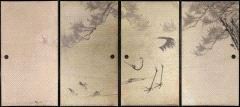Inkjet & Digital Printing
Production of high-resolution replicas of Golden Pavilion partition paintings gets underway

Wednesday 28. May 2008 - Canon Inc., in partnership with the Kyoto International Culture Foundation, announced today the selection of 18th century paintings on the partitions in the Ooshoin Room of Kyoto's Rokuon-ji Temple (also known as Kinkaku-ji Temple, or the Golden Pavilion) as the latest undertaking of the Tsuzuri Project,*1 a cooperative initiative that aims to preserve and pass on Japanese cultural assets to future generations using the latest digital technologies. Preparations are currently underway to produce high-resolution replicas of the artwork, which are scheduled for public display in autumn 2010.
The Ooshoin Room partition paintings*2 of Rokuon-ji Temple, comprising 50 decorated sliding-door panels that had adorned the five rooms of Rokuon-ji Temple’s Ooshoin, have been designated important cultural properties. The works are now stored in the Jotenkaku Museum within Shokoku-ji Temple, of which Rokuon-ji Temple is a branch temple. The paintings were created by Itoh Jakuchu, considered an artistic prodigy during the Edo period, by order of Daiten Osho, the 113th Head Priest of Shokoku-ji Temple, who recognized Jakuchu’s talents at an early stage.
These paintings have been hailed as outstanding examples of Jakuchu’s innovative creativity in the field of ink painting. While they have been deemed important cultural properties, as original artwork requiring storage, they are only displayed to the general public at the Jotenkaku Museum a few times each year.
Upon taking into consideration the historical and artistic importance of these paintings, the Tsuzuri Project decided to create high-resolution replicas of all 50 decorated sliding-door panels. The completed recreations will be donated to the Ooshoin Room of Rokuon-ji Temple, where the original panels had initially been on display.
Through the collaboration of the Kyoto International Culture Foundation, with vast experience and know-how in preserving cultural assets, and Canon, which possesses high-resolution, high-image-quality digital imaging technology, the Tsuzuri Project aims to continue contributing to the development of culture and society through art.
*1 The Tsuzuri Project, launched in March 2007, is an initiative organized by the Kyoto International Culture Foundation and supported by Canon as part of the former’s ongoing cultural heritage preservation activities. The project involves the digital recording of such important Japanese cultural properties as decorative byobu (folding screens) and fusuma (sliding doors), which have been passed down from ancient times. Through a unique combination of digital technology and traditional craftsmanship, high-resolution scale replicas, which are almost indistinguishable from the original work, are produced based on the original digitally recorded data. Large-format printers are used to print the replicas, to which skilled artisans apply gold leaf and backing as necessary. The creation of such replicas enable the original artwork to be stored in a controlled environment to prevent further deterioration, ensuring the prolonged preservation of priceless cultural assets.
*2 The Rokuon-ji Temple Ooshoin Room partition paintings were produced in 1759 by Itoh Jakuchu, an up and coming artist at the time, upon the recommendation of Daiten Osho as part of the refurbishing that was carried out by the head priest’s disciples. The location of Jakuchu’s tomb at Shokoku-ji Temple and its epitaph written by Daiten Osho suggest a friendly relationship between the artist and head priest.
“Pine and Crane” by Itoh Jakuchu, Partition Paintings from the Second Ooshoin Room, Rokuon-ji Temple
Project Overview: Rokuon-ji Temple (Kinkaku-ji Temple) Ooshoin Room Partition Paintings
Selected cultural assets : Rokuon-ji Temple Ooshoin Room partition paintings, 50 panels
Artist : Itoh Jakuchu (1716-1800)
Era : Edo period
Supervision : Mr. Johei Sasaki (President of National Institutes for Cultural Heritage,
Director of Kyoto National Museum)
Mr. Raitei Arima (Chief Servant of Head Temple Shokoku-ji Temple, Head
Priest of Rokuon-ji and Jisho-ji Temples, Head Director of Kyoto Buddhist Organization)
Cooperation : Head Temple Shokoku-ji of the Rinzai Buddhism, Rokuon-ji Temple
(Kinkaku-ji Temple), Jotenkaku Museum, Kyoto Buddhist Organization
Scheduled completion : Autumn 2010
